Introduction
Bedrock Cairn Sandals ($105, 8.5 ounces / 241 g each) are quasi-minimalist hiking sandals with a comfortable and secure webbing system, a precise fit, a durable and grippy Vibram sole, and a between-the-toe design.
I’d heard that Bedrock Sandals were comfortable, well-fitting hiking sandals that felt light but also provided enough mid-sole cushion to protect the feet on 15+ mile (25 km) days. I put these claims to the test in this review, and also discovered some unexpected benefits to the fairly unique webbing system.

About this review
I’ve been hiking in sandals for a long-time, though I’ve embraced the open-toe life in fits and starts over the years. My first experience with backpacking in sandals was while thru-hiking southbound on the Appalachian Trail, when the Merrill trail runners I was wearing completely fell apart after two-hundred miles of mud and rock abrasion in Maine. On the advice of a friend, I bought a pair of classic Chacos at an outfitter in New Hampshire and wore them for about 1,700 miles all the way to North Carolina, where the two feet of snow Superstorm Sandy dumped into the Smokies necessitated a footwear change.
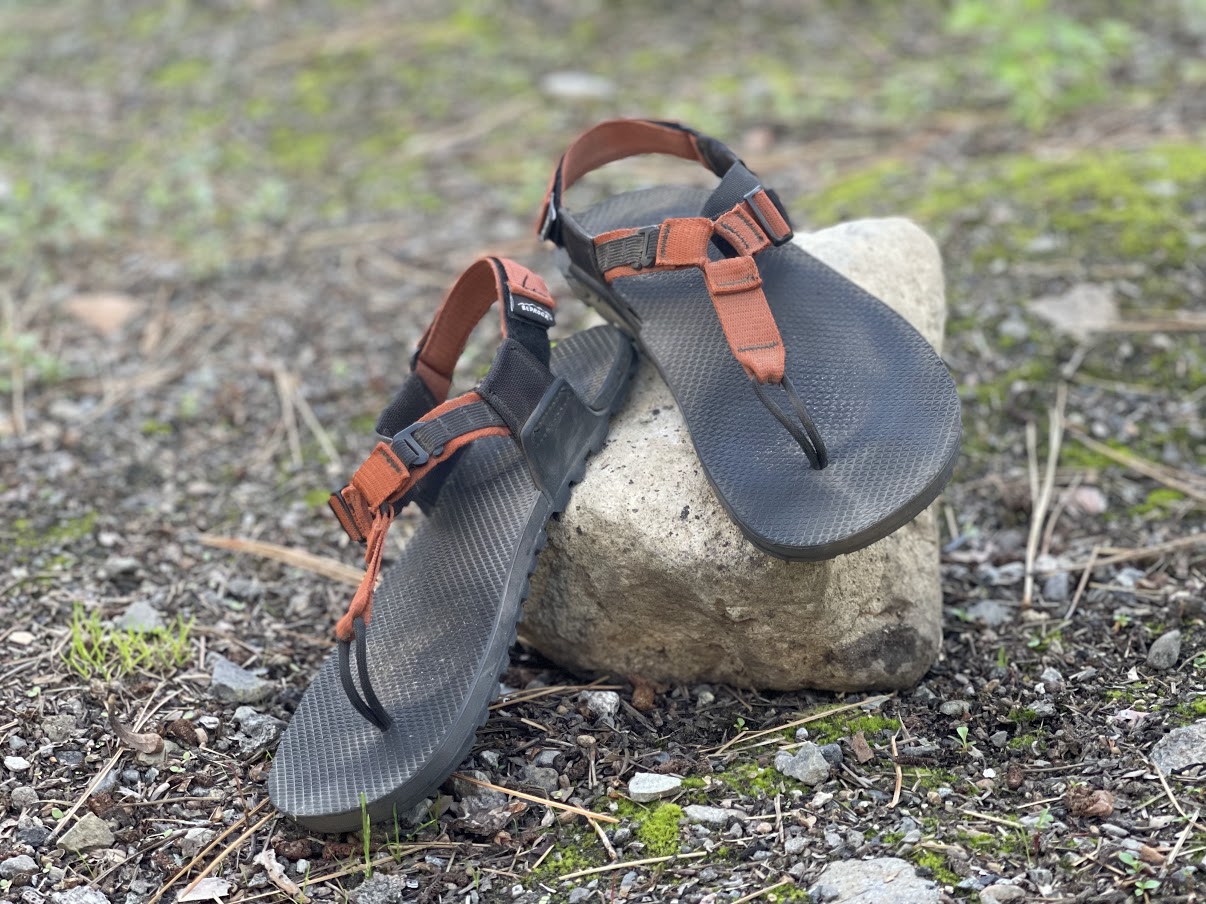
Since then, I’ve hiked in sandals on a thru-hike of the Colorado Trail, over a dozen multi-day backpacking trips, and more day hikes and short overnights than I can remember. My experience with hiking sandal styles runs the gamut from maximalist options like Chacos, through medium-cushion models like Tevas, and on down to ultra-minimalist styles like those from Xero Shoes.

Hiking in sandals – pros and cons
Sandals have advantages and drawbacks as compared to the most common type of ultralight backpacking footwear – trail runners. It’s worth examining these pros and cons now so that later in the review we can judge the Bedrock Sandals Cairn Adventure Sandals on their merits as sandals vs. focusing entirely on comparing them to trail runners (though we’ll do a bit of that too).
Hiking in sandals – pros
Blisters arise from moisture and abrasive material (dust and dirt) trapped within a footwear system. My feet in particular are prone to blisters in two scenarios:
- hot, humid environments with lots of mud and rain
- hot, dry environments with little shade and lots of very fine, sandy dust
Many backpackers find a simple switch from traditional boots and hiking shoes to flexible, relatively breathable trail runners enough to alleviate classic blister issues in these scenarios. Not so for me. I’ve tried it all – dozens of combinations of socks, balms, creams, and trail runners. So far the best system I’ve found for my feet is lightweight, relatively open-knit merino wool socks paired with zero-drop, wide-toebox shoes, and regular (almost hourly) application of Footglide – and this system is only blister-free about half the time.
Hiking sandals almost entirely remove the issue of trapped moisture (you can get a little moisture between the bottom of your foot and the rubber of a sandal footbed). Without the humid ecosystem of socks and shoes, the dirt picked up on the feet is much less likely to cause blisters. There’s no toe compression or rubbing, no laces to come untied, and no gaiters to fuss with.
Sandal wearers can splash through puddles with impunity, secure in the knowledge that even if it rains all day, they will not be sliding into clammy wet socks and half-dry trail runners the next morning.
Finally, sandals tend to be pretty durable. There’s no mesh to tear and no fabric seems to bust. And many sandals, Bedrock Sandals included, are resoleable – which feels good.
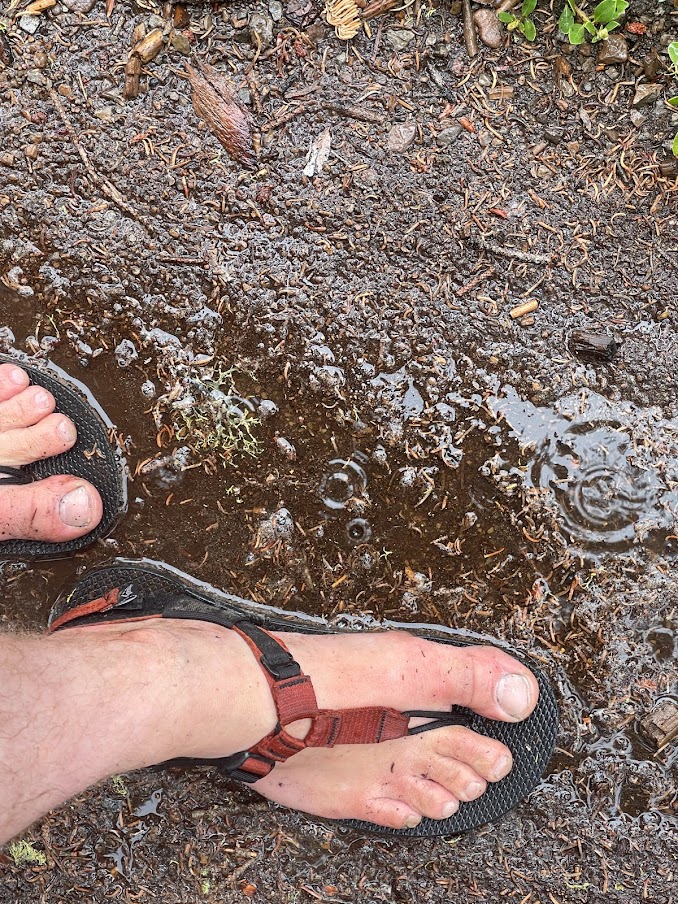
Hiking in sandals – cons
If sandals were a perfect ultralight backpacking footwear solution, everyone would be wearing them. They are not, and people aren’t. The most obvious problems are related to temperature and exposure to the regular hazards of the trail – abrasive sticks and rocks, insects, sun exposure, and so on. Sandals are obviously not well-suited for snow or frigid temperatures, though I’ve worn them successfully (without socks) in 50 °F (10 °C) daytime hiking temperatures. Using sandals in the proper scenarios – and with a certain degree of acceptance of the negatives in exchange for the positives – is helpful.
There are other, less obvious issues. One frequent problem is that small sticks and pebbles can sometimes get kicked up by footsteps and lodge between the foot and the footbed. Stepping through particularly silty puddles can also create this effect. It’s easy enough to stop and remove such obstructions, but it can mess up hiking rhythm, which is annoying. I’ve found the design of hiking sandals is a huge factor in how often this problem occurs. I’ll get into that further on in the review.
Another problem is that dry conditions can cause heels to crack. Heavily calloused feet are especially prone to this.
Some sandal designs have webbing and tensioning systems that put pressure on delicate areas of the feet, such as across the top of the phalange/metatarsal joints or the back of the Achilles tendon. And some sandals have poorly designed webbing patterns that cause abrasion where the webbing touches the skin. Some people’s feet don’t react well to contact with the hard rubber of sandal footbeds, and blisters on the bottom of the footpads are not unknown.
Many of the issues I just listed can be ameliorated by:
- Proper sandal choice and,
- muscle, bone, tendon, and skin adaptation via incremental increases in mileage.
Some people use socks to address these issues as well. I’m not a fan of this strategy because it adds complication and potential moisture back into the system, but many sandal hikers swear by a sock/sandal combo. Your mileage may vary.
Finally, while there are some sandals with deep, highly sculpted footbeds (i.e., Chacos) many sandal designs tend to lean towards the minimalist end of the spectrum. The conventional ultralight wisdom is that there is such a thing as too minimal of footwear, while backpacking (long miles under load). I don’t necessarily disagree with this, but I’ve personally had a lot of success backpacking in ultraminimalist shoes with little-to-no midsole cushioning. I enjoy the freedom, ground feedback, and featherlight sensation such footwear provides, and I’m willing to accept occasionally achy feet as a worthwhile tradeoff. But I’ve reached that point through many years of incremental foot adaptation and training. And of course, having the lightest possible pack helps as well.
In Our Archive – explore more backpacking light content on ultralight footwear:
- Minimalist Footwear and Trail Running Shoes for Hiking and Backpacking (trailhead)
- How to Choose Backpacking Footwear so You Can Keep Hiking Until You Die (wilderness skills)
- Minimalist Footwear for Backpacking? (tips, tricks, and hacks video)
- Interview with a Physio Therapist: A Biophysical Perspective on Backpacking Footwear (interview)
Features and specifications
- weight: 8.5 ounces (241 g) per size nine sandal
- stack height: 14 mm
- outsole rubber: Vibram XS Trek Regolith
- lug depth: 3.5 mm
- three possible adjustment points – 1 g-hook, 1 hook and loop strap, one webbing cinch
- 3/4 inch (2 cm) wide straps
- can be resoled
- USA assembled of domestic and foreign parts
- 1% of every purchase goes to environmental non-profits
Field Experience
I tested the Bedrock Sandals Cairn Adventure Sandals on multi-day backpacking trips, day hikes, and trail runs in the Sierra Nevada. I conducted my testing in the spring and early summer of 2022 on established trails.
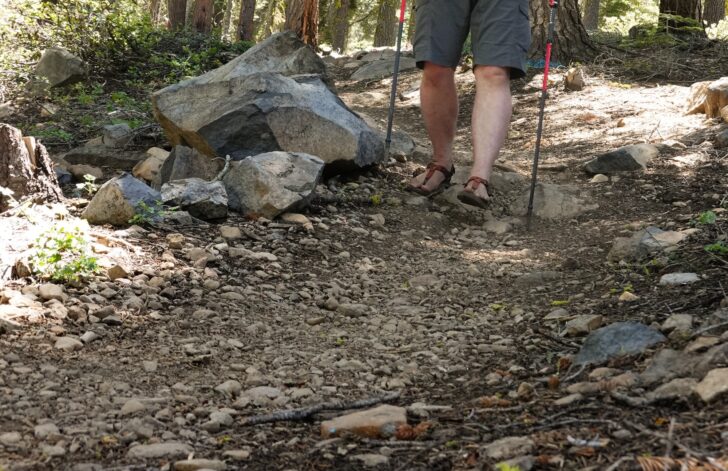
My loads were never more than 30 pounds (14 kg) and were often less. My longest testing day backpacking was 20 miles (32 km). My longest testing day trail running was 8 miles (13 km). Trail conditions were mostly dry hardpack with a layer of loose gravel and dust on top, with two instances of wet, puddled trails and slippery rocks due to all-day rain.

Temperatures during testing ranged from 50 °F to 85 °F (10 °C to 29 °C).
In our Forum: See what our community has to say about hiking in sandals
Performance analysis
I judged the performance of the Bedrock Sandals Cairn Adventure Sandals on the basis of:
- webbing/strap system
- weight
- midsole/outsole
- footbed
Since this is a Limited Review, I won’t present a detailed performance analysis based on long-term use. Instead, I’ll note my initial performance observations and issues below. Read more about our types of reviews here.
Webbing/strap system
As I mentioned towards the top of this article, I’ve been backpacking, hiking, and running in sandals for just over ten years now, and the Bedrock Sandals Cairn Adventure Sandals have the most secure, comfortable, well-fitting strap system I’ve ever used. I’m not alone in this opinion – in researching for this review, the fit of these sandals is the most remarked upon feature in comments and forums.

The system works like this:
- A nylon loop runs from the footbed, up between the big and second toe, and connects with webbing just at the base of the toes.
- That webbing runs up to a t-intersection with two other webbing straps, both of which connect to wings on the side of the sandals right at the back of the foot arch.
- Both of these straps are adjustable, although only one needs to be adjusted on a regular basis (to get the sandals on and off and to make minor tension adjustments on the fly).
- A hook-and-loop strap runs around the back of the heel from wing to wing.
- The tightening of the hook and loop strap moves the foot forward on the footbed, and loosening it allows the foot to slide further back towards the rear of the footbed.
- Cinching the right-hand strap secures the webbing in place around the base of the ankle, which creates a fit that is secure while also being comfortable.

This system is quite different than that used by most other hiking sandals. For more on this, see my commentary section.
Weight
The Bedrock Sandals Cairn Adventure Sandals weigh about 8.5 ounces (241 g) each for a men’s size nine. That puts them at about 1 ounce (28 g) lighter than a comparable size in my current favorite zero-drop, wide-toebox trail runners, the Inov8 TRAILFLY G 270s (formerly TERRAULTRA G 270s). And they are 2 ounces (57 grams) lighter than comparably sized Altra Lone Peak 6s.
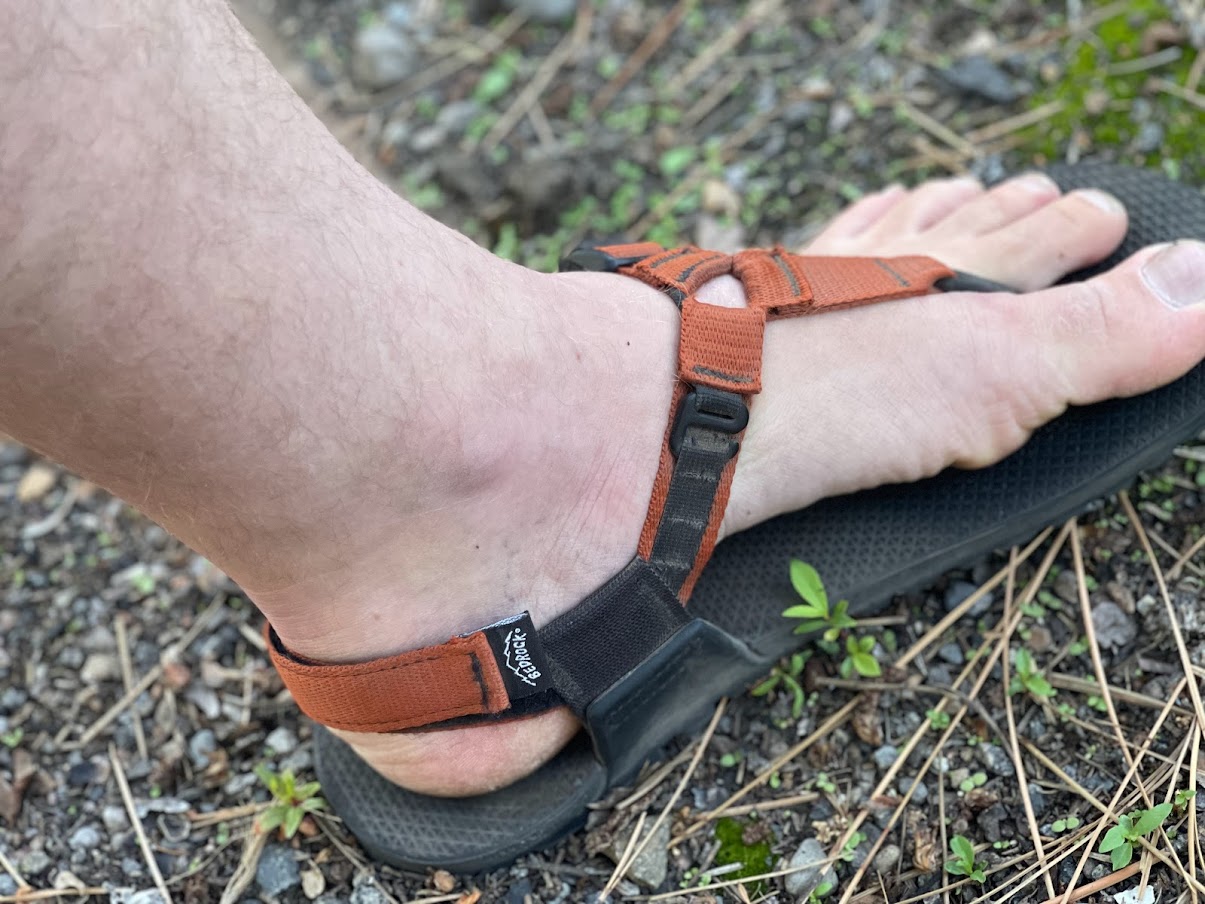
How does this weight stack up to other popular hiking sandals? Let’s take a look.
Table Notes: All weights reflect men’s size nine. Many of the brands featured here have more than one sandal type. I tried to choose models that are either go-to choices for sandal hikers (Chaco Z1/Classic) or are middle-of-the-road options as identified by the brand.
| Bedrock Sandals Cairn Adventure Sandals | 8.5 ounces (241 g) |
| Chaco Z1/Classic | 14.9 ounces (422 g) |
| Teva TERRA FI 5 Universal | 14.3 ounces (403 g) |
| Luna Middle Bear Winged Edition | 8.2 ounces (232 g) |
| Xero Shoes Z-Trail EV | 5.4 ounches (153 g) |
The Bedrock Sandals Cairn Adventure Sandals sit smack in the middle of the weight table, totally outclassing the (thicker, more classically supportive) Chaco and Teva options. Cairns are roughly even with the modal from Luna that I chose, and that makes sense as they seem to share a design philosophy and midsole thickness. Look at how similar their profiles are.


Xero Shoes is known for its minimal footwear offerings, so it’s perhaps no surprise that their Z-Trail EV is only 5.4 ounces (153 g). That weight comes with less cushioning in the midsole, however.
In short, Bedrock Sandals seems to have found a bit of a middle ground with the Cairns. They certainly felt light enough on my feet, and I’ve spent the last few years in minimalist footwear of all types. Weight also ties into issues like ground feel, foot comfort and pain, and durability, so we’ll move into those issues next.
Midsole/Outsole
Bedrock Sandals Cairn Adventure Sandals have a stack height of 14 mm, which again places them pretty much in the middle of the hiking sandal family in terms of thickness (and also contributes to their middle-of-the-road weight). I found this stack height plenty thick enough to protect from stone bruises. Backpackers with loads over 30 pounds (14 kg) might feel some foot pain around the end of the day; I started to get achy feet about mile twenty, which is pretty normal for me no matter what type of shoes I’m wearing.
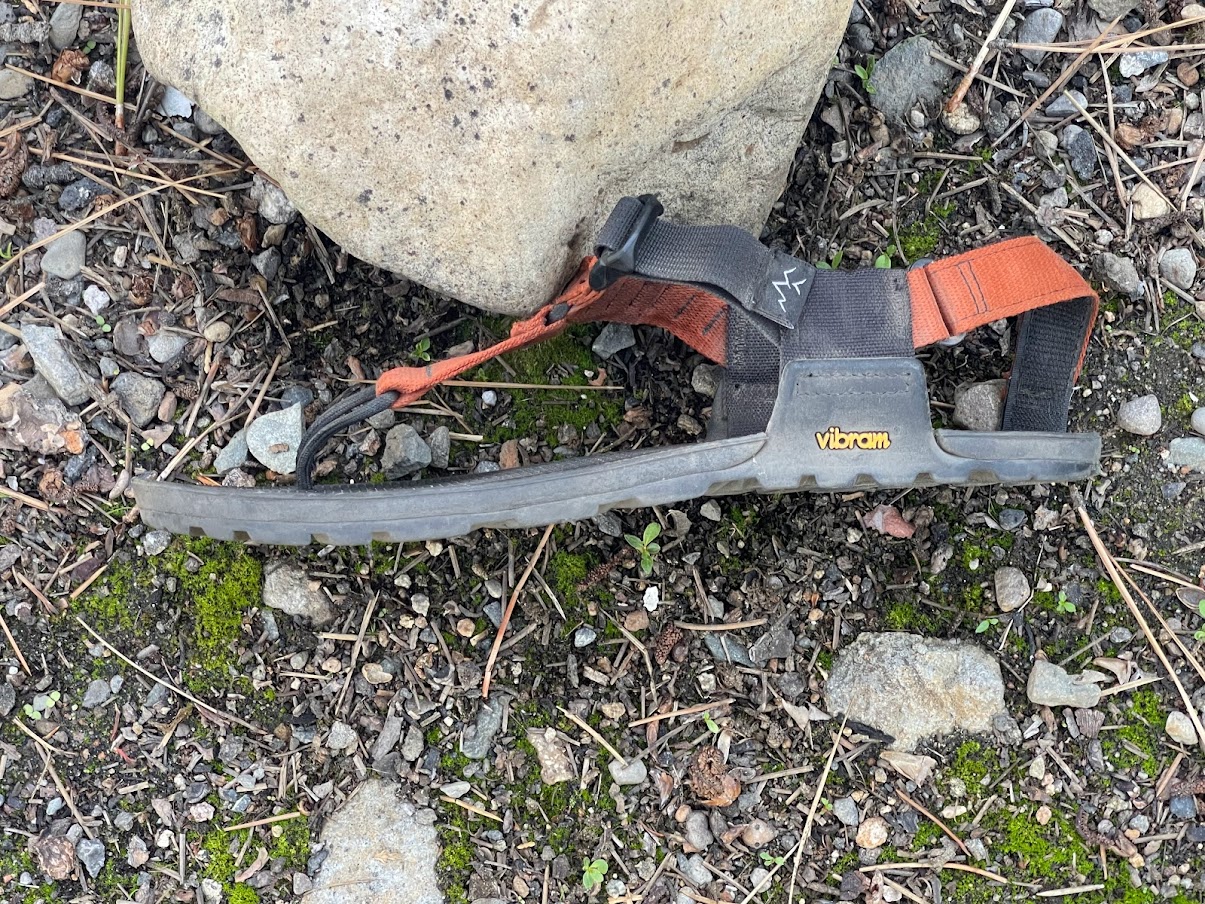
Bedrock Sandals chose a Vibram XS Trek rubber with 3.5 mm lugs for the outsole of the Cairns. Vibram says XS Trek is a good middle-ground between grippy and hard-wearing. After testing on loose soil, stone, and in wet, muddy conditions, I tend to agree. The tread pattern Bedrock chose isn’t my favorite in the hiking sandal family (that honor goes to the Luna Bear Winged Edition) but it’s far from my least favorite.
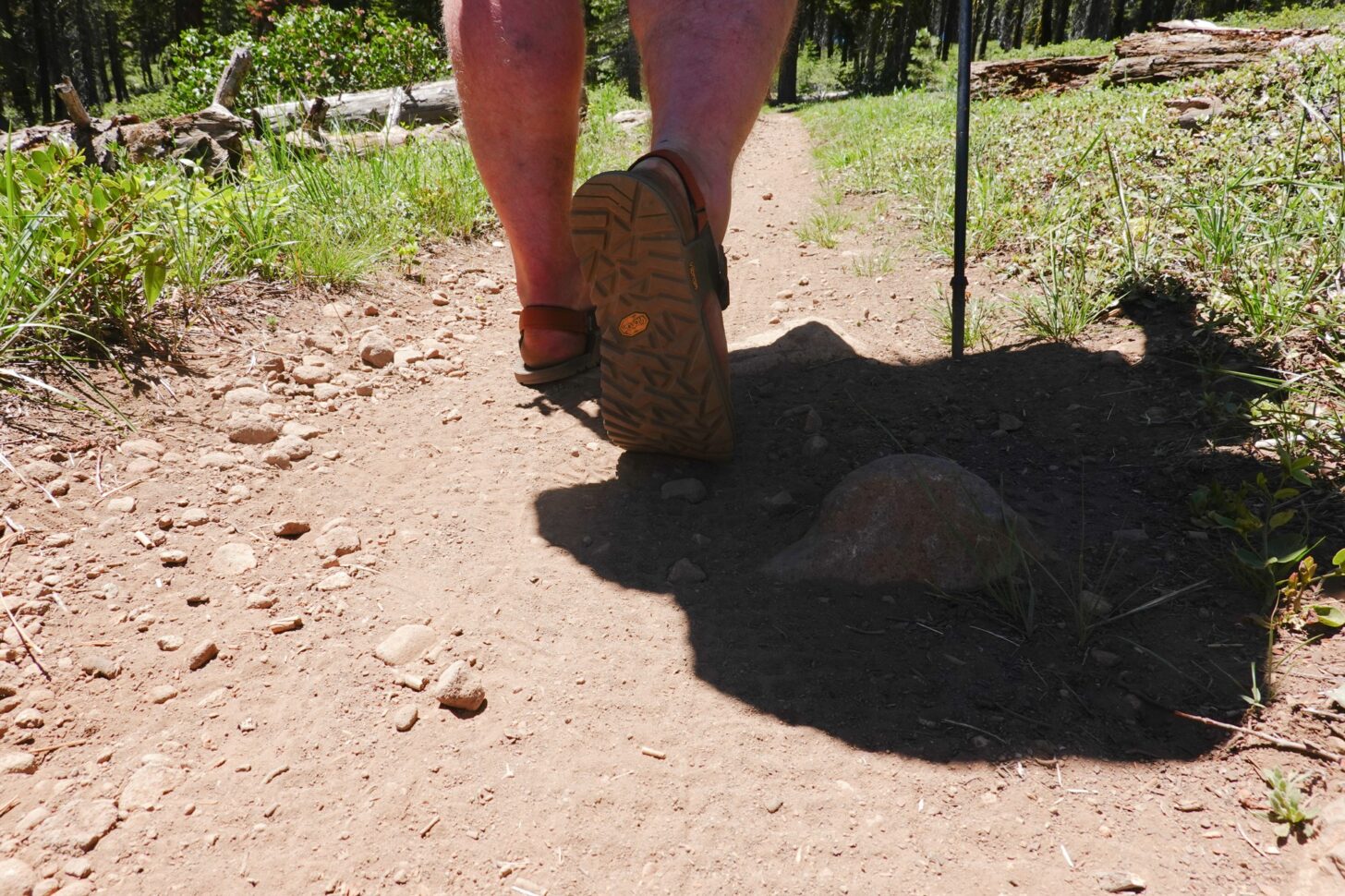
I’d rank the combination of rubber and tread pattern near the top of class in dry conditions and middle-of-the-road for slippery rocks and mud. Bedrock Sandals offers a stickier but presumably less durable rubber on the Cairn PRO II Adventure Sandals . I’m planning on testing those on my next trip on muddy Appalachian paths.
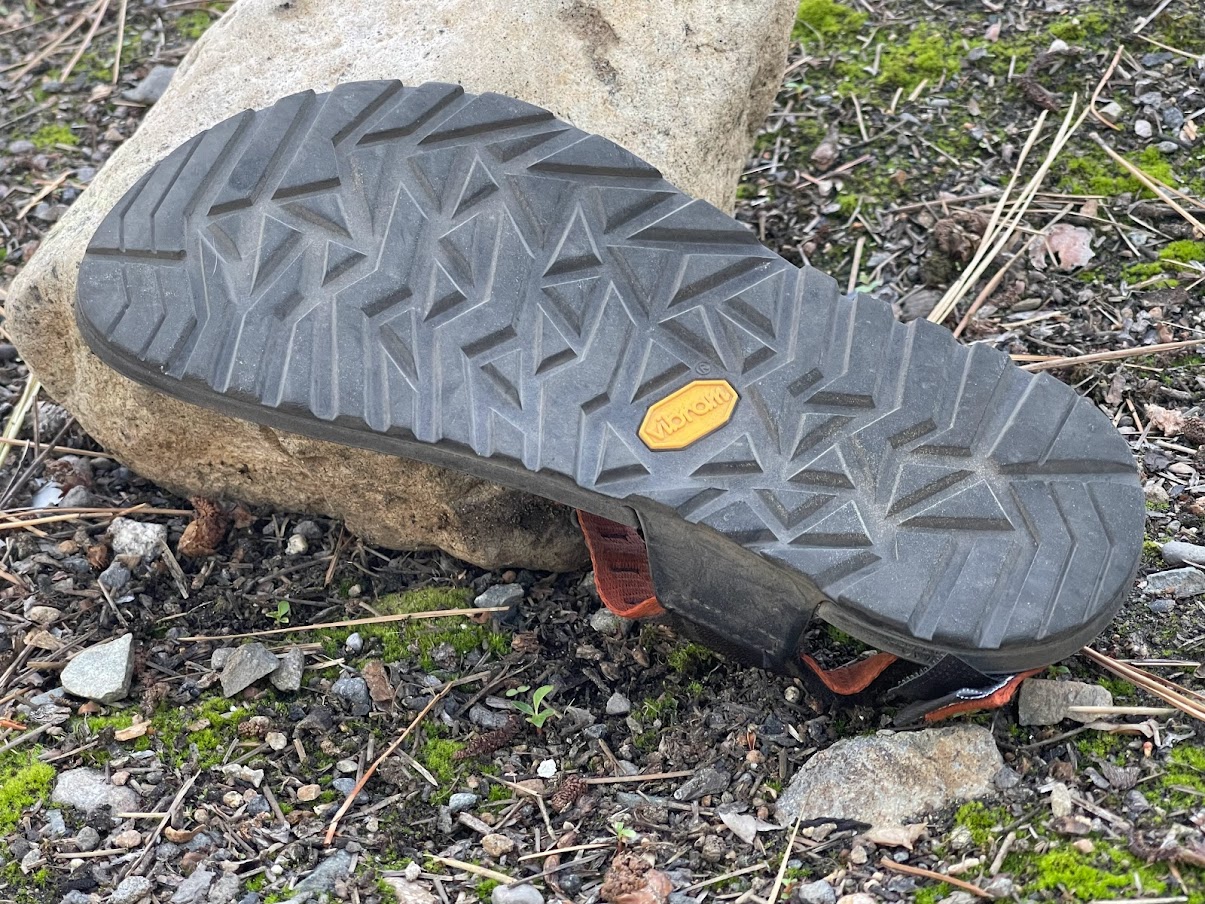
Footbed
The Cairns are zero-drop and have a middling-to-narrow footbed. Bedrock Sandals utilizes a clever printable sizing system that allows you to place your foot on an outline of your suspected size to see just how things line up before you purchase.

Cairns are available in two footbed styles – flat and sculpted. I opted for flat because I wanted to test my theory that sculpted sandal footbeds trap more twigs and rocks than flat footbeds. And indeed, in my testing, I had to stop and fish out debris far less than I did when wearing sandals with sculpted footbeds. This could also be a factor of the Cairns secure tensioning system.
Commentary
What makes Bedrock Sandals Cairn Adventure Sandals Unique?
I want to talk more about the fit of Bedrock Sandals Cairn Adventure Sandals.

As compared to many other sandal brands, the chief things of note here are:
- There are four separate webbing straps, none of which run through the sole. Continous webbing is a feature of many hiking sandals that supposedly allows for a dialed-in fit, but in practice, I find it hard to adjust, susceptible to fit creep in wet conditions, and difficult to get comfortable in the first place, with some section of the webbing always being too tight or too loose.
- When the primary tightening strap is tensioned, the force is applied around the front, across the transitional bones between the ankle and the metatarsals.
- The toe thong and heel strap mostly keep the front and back of the sandal from flapping around. Designs like those used by Teva, Chaco, and Xero Shoes put pressure around the back of the ankle over the Achilles tendon, at the base of the toe joints, and across the top of the metatarsals.
I’m not a doctor. And I have put in over 2,000 successful miles (3219 km) in sandals of the Chaco/Teva/Xero Shoes webbing design. But I’ve also experienced some foot pain and repetitive use injury.
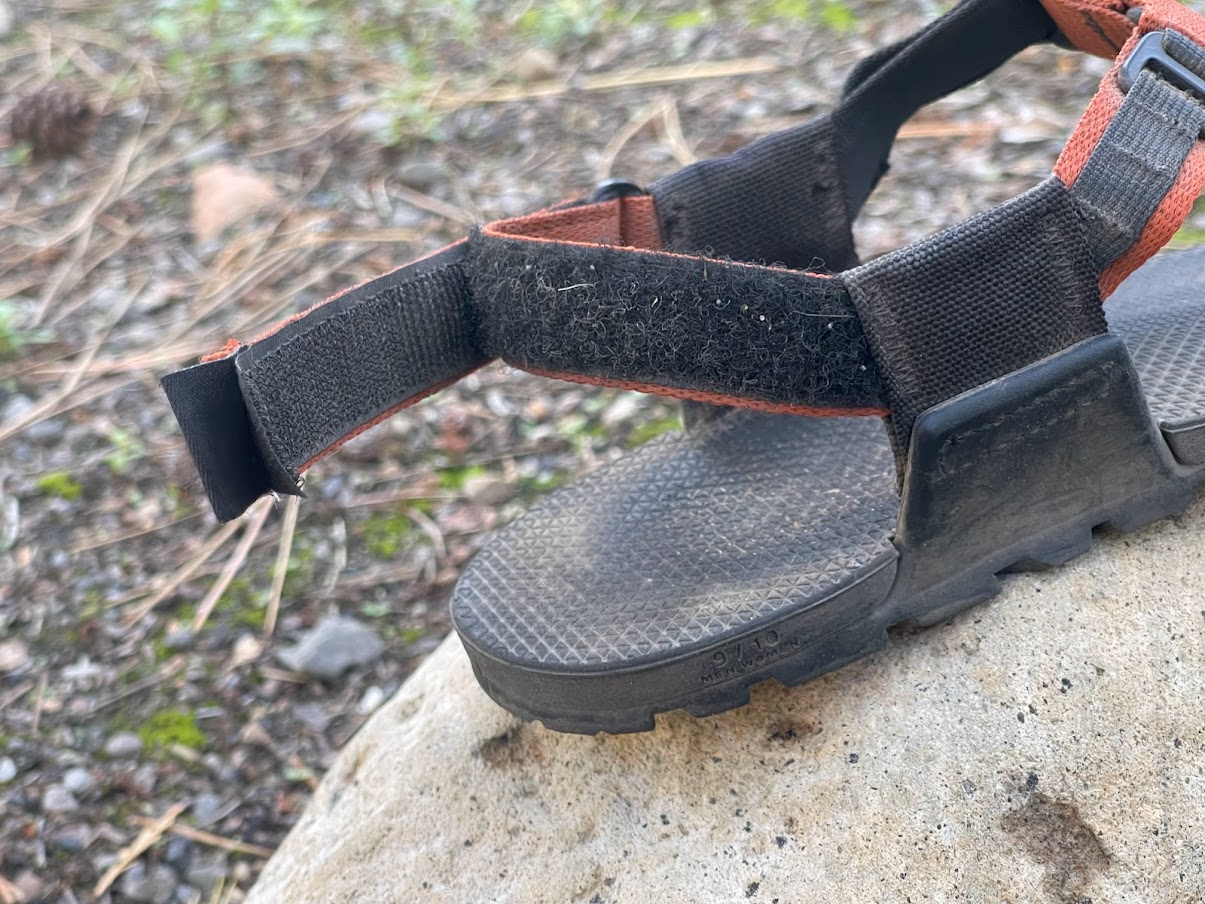
Looking at foot anatomy and comparing that to where I have felt sandal-related pain in the past (Achilles tendon, metatarsals, metatarsal/proximal phalange joints) I can make an inference about what is causing that pain. If I was thru-hiking in sandals (and I fully plan to do so again) I would choose a sandal with a webbing design of the Bedrock Sandals type. For what it’s worth, Luna Sandals also utilizes a variation of this design, and I’m sure there are others out there as well.
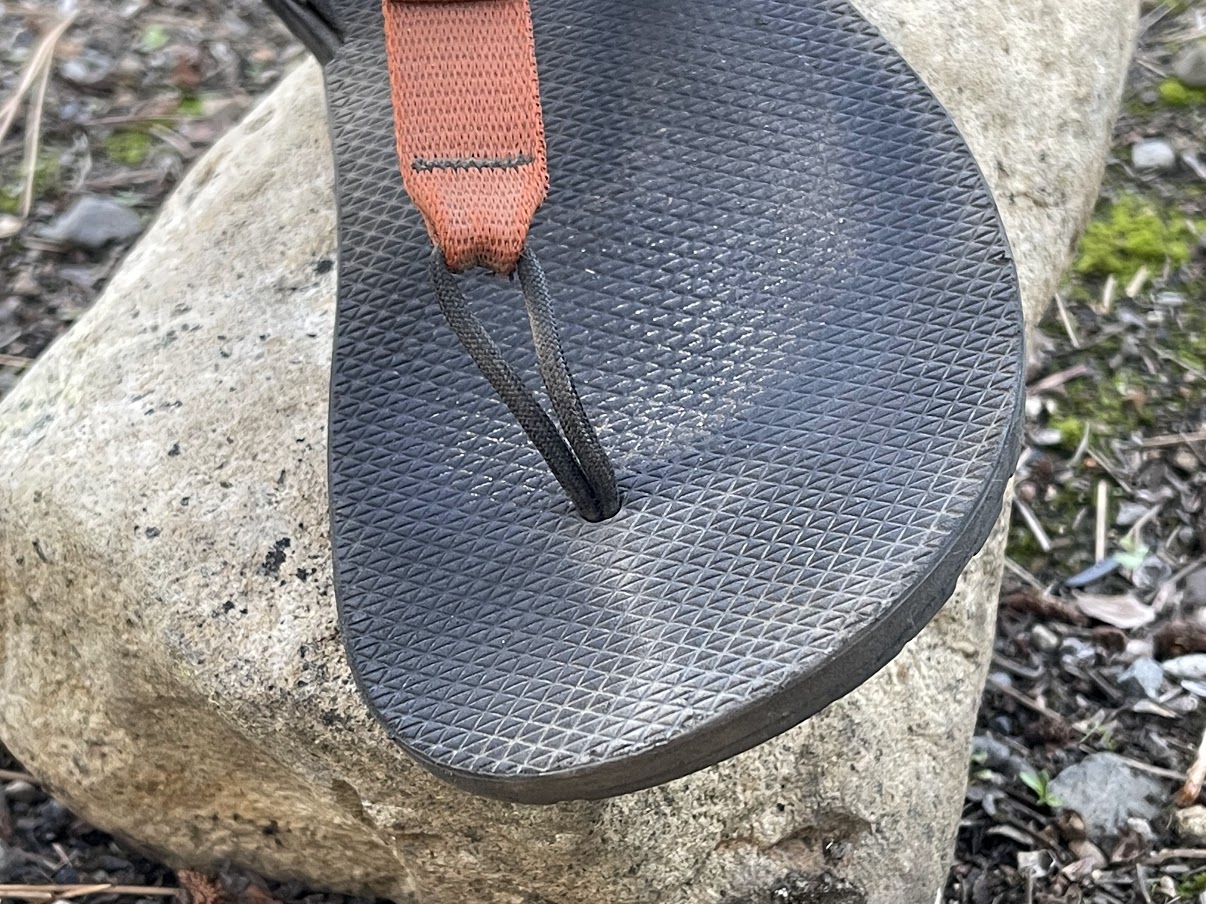
Bedrock Sandals Cairn Adventure Sandals Compared to Chaco Z/1 Classics
I chose to compare the Bedrock Sandals Cairn Adventure Sandals to the Chaco Z/1 Classics. The two sandals are about as different as hiking sandals can be, but I believe illuminating these differences is worthwhile.
Additionally, though I have tried many types of hiking sandals and have increasingly moved towards minimalist styles, I still have the most miles by far in Chaco Z/1 Classics. Finally, Chacos have a huge market share and brand recognition, are widely available, and have a bit of a mythos (search Chaco tan online). I believe they are still the hiking sandal most likely to be recommended by your average gear shop employee.
Weight
Bedrock Sandals Cairn Adventure Sandals weigh half as much as Chaco Z/1 classics. There is no competition here.
Edge: Bedrock Sandals Cairn Adventure sandals
Price
Cairn Adventure Sandals are five bucks more expensive than classic Chaco Z/1s.
Edge: Chacos, barely.
Tensioning System
Chaco Z/1s have a “continuous” webbing system that runs through the sole of the sandal and is hard to tension precisely, especially when grit and dirt clog the areas where the webbing enters the midsole. The rear webbing strap is not adjustable, and the webbing straps run over top of delicate areas of the foot.
Bedrock Sandals Cairn Adventure Sandals utilize a four-piece, highly adjustable webbing system with tension force around the upper foot/lower ankle as opposed to the delicate bones of the feet.
Edge: Bedrock Sandals Cairn Adventure Sandals by a mile.
Footbed/Midsole
The classic Chaco footbed has remained unchanged for decades, and it has a lot of die-hard fans. Personally, I’m no longer convinced the weight tradeoff (and resulting energy expenditure) is worth the extra cushioning and support. But adapting to minimalist-style footbeds requires time and patience. Furthermore, a dialed-in kit on your back is crucial for backpacking with minimalist shoes. I’m willing to believe there are users who will find the Chaco footbed and midsole more useful.
Edge: Tie, use-case and user-dependent.
Outsole
It appears that Chaco has changed the tread pattern on the Z/1 Classic since I last put some miles on some. But looking at photos of the newest version, I’m still seeing some channels that run along the vertical (toe to heel) axis of the sole. I’m not a fan of that pattern, as I tend to think it leads to slippage in dusty, loose soil. I much prefer the angular, geometric pattern on the Cairn Adventures. Both sandals have a lug depth of 3.5 mm.
Edge: Bedrock Sandals Cairn Adventure Sandals
Strengths
- comfortable and secure tensioning system
- strikes a middle ground among hiking sandals for weight and stack height
- rubber and tread pattern performs very well in dry conditions and well enough in wet conditions
- minimalist-style flat footbed
- can be resoled
Limitations
- packrafters, canoeists doing portage, and hikers in extremely wet and muddy conditions might want to consider a sandal with a softer, more grippy outsole rubber, such as the Cairn PRO II Adventure Sandals
- hikers with +30 pound (480 kg) loads or sensitive knees and feet might want a sandal with a thicker, more supportive footbed
Where to Buy
You can buy Bedrock Sandals Cairn Adventure Sandals on the Bedrock Sandals website and at REI.
Learn more
Browse our curated recommendations in the Backpacking Light Gear Shop – a product research & discovery tool where you can find Member gear reviews, Gear Swap (used gear) listings, and more info about specific products recommended by our staff and members.
Gear Shop » Footwear
Related content
- read more by Andrew Marshall
- listen to our foot injury podcast with physical therapist and athletic performance coach John Zombro
DISCLOSURE (Updated April 9, 2024)
- Backpacking Light does not accept compensation or donated/discounted products in exchange for product mentions or placements in editorial coverage. Some (but not all) of the links in this review may be affiliate links. If you click on one of these links and visit one of our affiliate partners (usually a retailer site), and subsequently place an order with that retailer, we receive a commission on your entire order, which varies between 3% and 15% of the purchase price. Affiliate commissions represent less than 15% of Backpacking Light's gross revenue. More than 70% of our revenue comes from Membership Fees. So if you'd really like to support our work, don't buy gear you don't need - support our consumer advocacy work and become a Member instead. Learn more about affiliate commissions, influencer marketing, and our consumer advocacy work by reading our article Stop wasting money on gear.

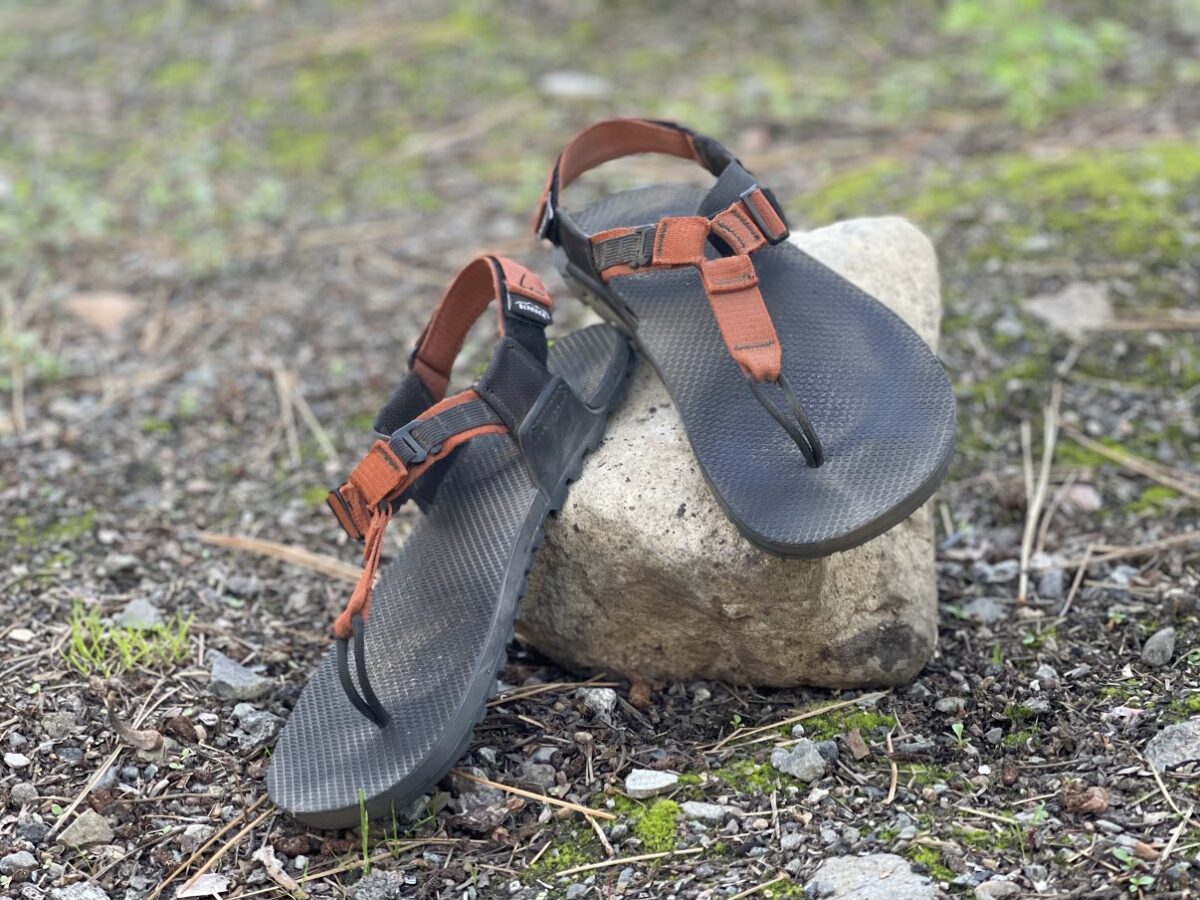


Home › Forums › Bedrock Cairn Sandals Review